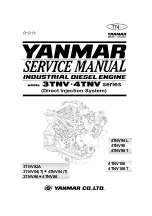
Thank you for choosing a Magnum XL RFS series aircraft engine. The
XL .52RFS is a single cylinder, four-stroke engine incorporating an aluminum
piston, iron ring, and steel sleeve for long life and high power output. The
engine features a dual needle valve rear updraft carburetor for precise
fuel/airflow metering, dual ball bearing-supported crankshaft and camshaft,
dual bushing-supported connecting rod, and a high-flow quiet muffler. Your
Magnum XL RFS series engine was designed by expert engineers and
built by master craftsmen using only the highest quality materials and CNC
machinery. These qualities provide the long life and dependability you have
come to expect from an engine of this caliber.
Magnum XL RFS series model aircraft engines will consistently give you
dependable performance and reliability and will be a source of satisfaction
and pleasure if you follow these instructions as to the engine’s proper and
safe use. You alone are responsible for the safe operation of your engine, so
act sensibly and with care at all times. This Magnum XL RFS series model
aircraft engine is not a toy. It is a precision-built machine whose power is
capable of causing serious injury to yourself and others if abused or misused,
or if you fail to observe proper safety precautions while using it.
l
Keep spectators, especially small children, at least 20 feet away from the
engine while it is running.
l
Mount the engine securely in the aircraft or on a suitable engine test stand
to run the engine. Follow the mounting instructions in your aircraft's
instruction manual or on the plans for individual mounting recommendations.
Do not clamp the engine in a vise to test-run it.
l
Use the recommended size propeller and follow the proper procedure for
mounting the propeller. Use the correct size wrench to tighten the propeller
nut and the safety nut.
Do not use pliers.
l
Inspect the spinner, propeller, propeller nut, and the safety nut on a regular
basis, looking for any signs of nicks, cracks or loosening.
l
To stop the engine, adjust the throttle linkage to completely close the throttle
barrel and therefore cut off the fuel/air supply. You can also pinch the fuel
line to stop the engine, but only if it is accessible.
Do not throw anything into
the spinning propeller or attempt to use your hands to stop the engine.
l
While the engine is running, stand behind the engine to make any adjustments
to the needle valves. Do not reach over or around the propeller. Do not lean
toward the engine.
Do not wear loose clothing or allow anything to be
drawn into the spinning propeller while the engine is running.
l
If you need to carry your model while the engine is running, be conscious
of the spinning propeller.
Keep the aircraft pointed away from you and
others at all times.
l
Do not use a tight-fitting cowl over the engine. It can restrict air from flowing
over the engine, which could result in engine damage from overheating.
For proper cooling, the total cowl air-exit area should be 30% greater
than the total air-intake area.
1
Global Services
l
18480 Bandilier Circle
l
Fountain Valley, CA 92708
l
Phone: (714) 963-0329
l
Fax: (714) 964-6236
l
Email: [email protected]
For product warranty information, please refer to the
warranty card provided with your engine.
Magnum XL RFS series engines are distributed exclusively by Global Hobby Distributors
All contents copyright © 2009, Global Hobby Distributors, September 2009
Displacement .............................................
52ci (8.53cc)
Bore / Stroke ..............................................
23mm / 21mm
Practical RPM ............................................ 2,000 - 10,500
Weight w/Muffler
........................................
15.7oz
Crankshaft Thread Size
............................. 1/4-28
l
Ringed Piston Design for Long Life and High Power
l
Dual Ball Bearing-Supported Crankshaft and Camshaft
l
Dual Bushing-Supported Connecting Rod
l
High-Flow Quiet Muffler
l
Dual Needle Valve Rear Updraft Carburetor
Engine Orientation
Your XL RFS series engine can be orientated in any position on the firewall.
Keep in mind that when the engine is mounted inverted, carburetor
adjustments will need to be made differently and the fuel tank may need to be
lowered. (See fuel tank size and orientation to carburetor on the next page.)
XL .52RFS AIRCRAFT ENGINE
SPECIFICATIONS AND FEATURES
INTRODUCTION
BECOMING FAMILIAR WITH YOUR ENGINE
If you are familiar with the operation of four-stroke model engines or just
can't wait to run your new engine, please read through the Quick-Start
Guide included. The Quick-Start Guide will help you get started right away
and also includes recommendations for items required to run your new
engine. We do recommend reading through these Operating Instructions
in their entirety to familiarize yourself with the features and operation of
your new engine. We have also included a Troubleshooting Guide should
you encounter any problems. Please use the photos below to familiarize
yourself with the components of your new Magnum XL RFS series engine.
CAUTION - PLEASE READ BEFORE USE!
ENGINE INSTALLATION
XL .52RFS
RINGED FOUR-STROKE
AIRCRAFT ENGINE
P/N 210851
*Due to continued manufacturing changes
and improvements, your engine may differ
slightly from that shown.
OPERATING
INSTRUCTIONS
Valve Cover
Muffler
Pressure Nipple
Pushrod Tubes
Camshaft
Housing Cover
Crankshaft
Prop Nuts
and Washer
Drive
Washer
Breather Nipple
Intake Pipe (Manifold)
Carburetor
Cylinder Head
Backplate
High Speed Needle Valve
Low Speed
Needle Valve
Throttle Arm
Rotor Bolt
Idle Stop
Screw
Fuel Nipple
Detent
Spring


























